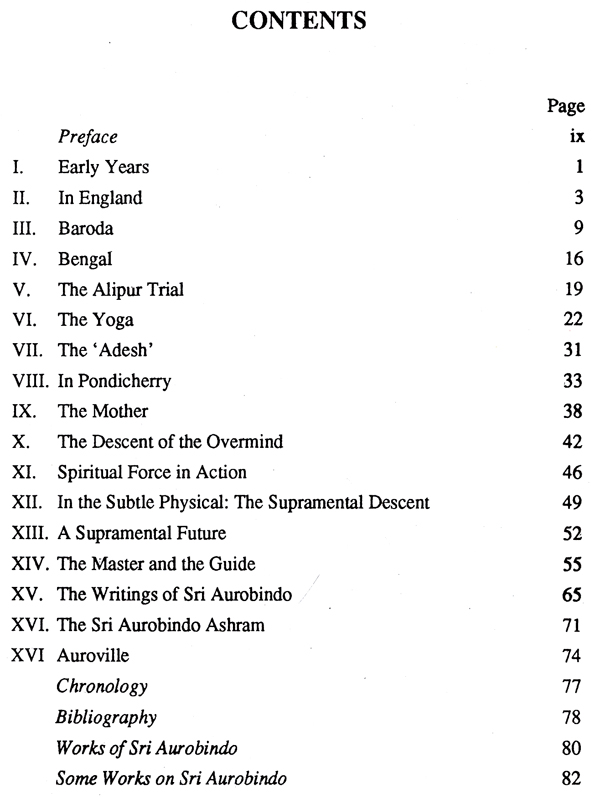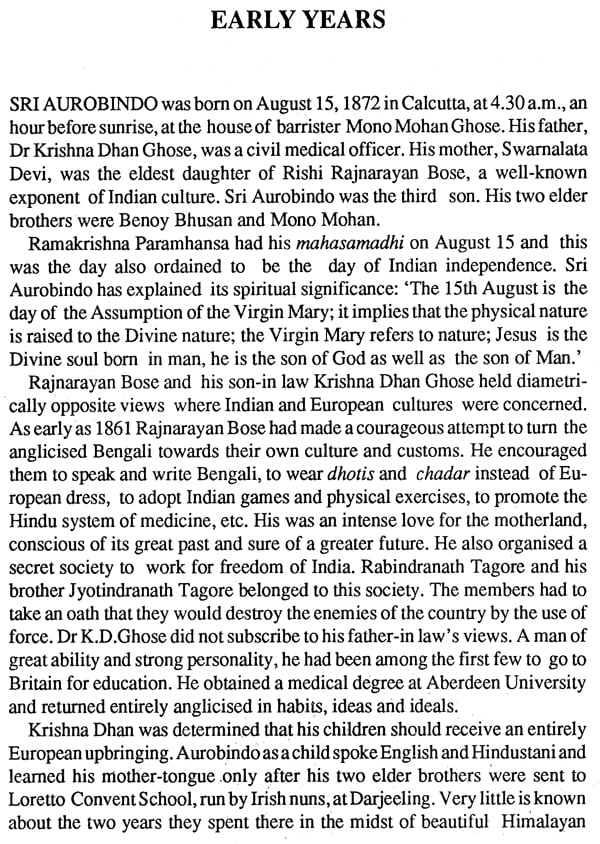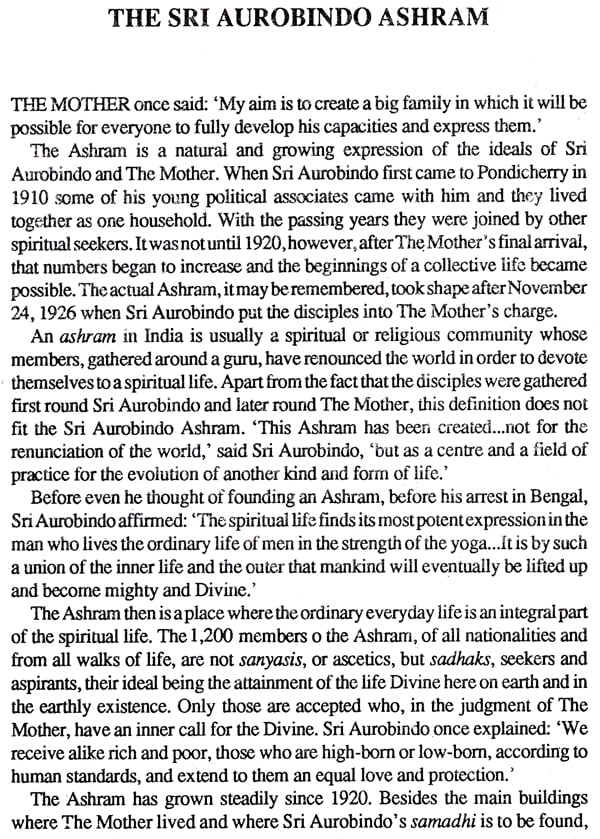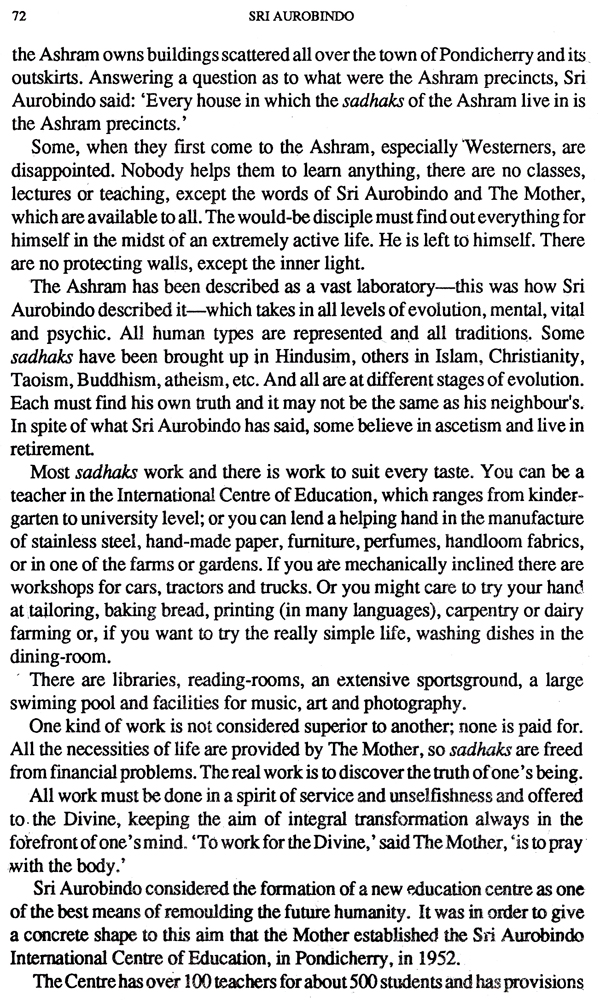
Navajata
Book Specification
| Item Code: | NAT352 |
| Author: | Sri Aurobindo |
| Publisher: | National Book Trust, India |
| Language: | ENGLISH |
| Edition: | 2013 |
| ISBN: | 9788123700366 |
| Pages: | 96 (14 B/W Illustrations) |
| Cover: | PAPERBACK |
| Other Details | 8.50 X 5.50 inch |
| Weight | 150 gm |
Book Description
Sri Navajata (1922-1983), the author of the book, was Chairman of the Sri Aurobindo Society and Auroville, an international cultural township dedicated to the realisation of the ideals of human unity, integral progress and research in a model community. He was actively engaged in interpreting Sri Aurobindo's vision of the future and was working for its realisation.
THOUSANDS of people visiting the Sri Aurobindo Ashram at Pondicherry happily partake of the pervading peaceful atmosphere which is most marked in the main building.Here in the courtyard is the samadhi of Sri Aurobindo and The Mother. A huge tree (botanical name Peltophorum nferrugineum), about 35 ft in height and named by The Mother, The Service Tree, forms a natural canopy over the samadhi. Around the samadhi, sadhaks and visitors alike meditate: some aspire to open themselves to the Divine consciousness; others concentrate on realising a total supramental transformation, while others yet again offer their worldly sorrows and difficulties at the feet of Sri Aurobindo and pray for his help. It is no wonder that they all receive help according to their receptivity, because The Mother has said: 'Sri Aurobindo has not left us-Sri Aurobindo is here as living and as present as ever and it is left to us to realise his work with all the sincerity, eagerness and concentration necessary.' And again: 'Lord, this morning Thou has given me the assurance that Thou would stay with us until Thy work is achieved, not only as a consciousness but also as a dynamic presence in action. In unmistakable terms Thou has promised that all of Thyself would remain here and not leave the earth atmosphere until earth is transformed. Grant that we may be worthy of this marvellous presence and that henceforth everything in us be concentrated on the one will to be more and more perfectly consecrated to the fulfilment of Thy sublime work.'
Sri Aurobindo left his body in the early hours of the morning (at 1.26 a.m.) on December 5, 1950. A supramental light enveloped his body, stopping its decomposition. So the body lay in state for over four-and -a-half days and was laid in the samadhi only on the afternoon of December 9, 1950. On the marble samadhi, always bedecked with beautifully arranged flowers, are inscribed the following words:
To THEE who hast been the material envelope of our Master, to THEE our infinite gratitude. Before THEE who has done so much for us, who has worked, struggled , suffered, hoped, endured so much, before THEE who has willed all, attempted all, prepared, achieved all for us, before THEE we bow down and implore that we may never forget even for a moment, all we owe to THEE.
The question naturally arises: how did Sri Aurobindo will all, attempt all, prepare and achieve all for us?
An answer to this query is at once difficult and easy. `No one can write about my life because it has not been on the surface for man to see,' wrote Sri Aurobindo. But what little has been on the surface for man to see is itself overwhelming. Moreover, in his writings Sri Aurobindo has thrown light on his inner life and actions and on what he has done for mankind. In this book we have tried to reproduce as far as possible Sri Aurobindo's own words, so that the reader may appreciate them according to his own level of consciousness and benefit from the spiritual power all his writings carry.
Sri Aurobindo is remembered as a great nationalist who fought for India's independence, admired as a great writer and poet, revered as a great yogi-but all these eulogies are our limited assessment of his Divine personality.
Various theories have been advanced concerning an ascending evolution in nature which goes from the stone to the plant, from the plant to the animal, from the animal to man. In India the process of evolution has been symbolised in the Puranic description of the ten avatars: Matsya, Kunna, Varaha, Nirsingh, Vaman, Parashuram, Ram, Krishna, Buddha and Kalki. Sri Aurobindo says that in this process of evolution man is only a transitional being, not the last; he will be surpassed He is living in a mental consciousness; he has latent faculties in him, facul-ties beyond mind and intuition the truth-consciousness, the Supermind. Even though in the natural course of evolution the Supermind will evolve, that will take thousands of years. This evolution, however, can be expedited here and now. Then life on earth will change; the mind of man will become a mind of light in which all knowledge will be self-possessed and even the physical body will undergo a transformation, becoming a body of light. Everything on earth will change. The life Divine will become a palpable fact.
The true significance of this will come home to all after the integral transformation has taken place and even the body has changed. Today only a few can visualise it. The future will hail Sri Aurobindo as an avatar who ushered in the Supramental Age. The Mother has said in this connection: ' Sri Awobindo incarnated in the human body the supramental consciousness and has not only revealed to us the nature of the path to follow and the method of following it so as to arrive at the goal, but has also by his own personal realisation given us the example; he has provided us with the proof that the thing can be done and the time is now to do As an avatar who came to lead the earth to a supramental transformation, he naturally had to bear the brunt of battle with the forces of nature. In Savitri, his epic poem, sri Aurobindo expresses this in the following lines:
But when God’s messenger comes to help the world
And lead the soul of earth to higher things,
He must carry the yoke he came to unloose, He too must bear the pangs that he would heal.
**Contents and Sample Pages**










